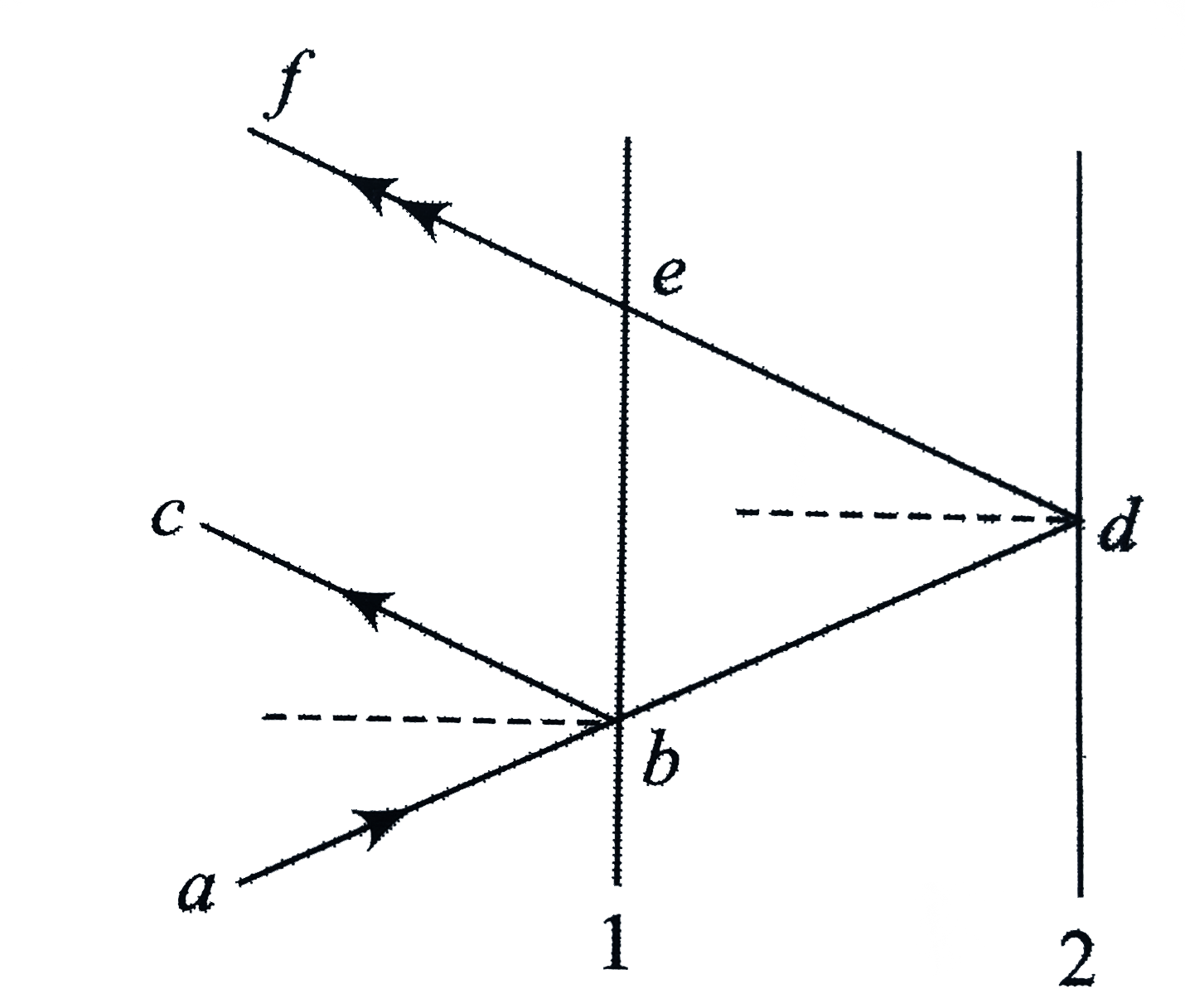A short light pulse of enegry E=7.5J falls in the form of a narrow and almost parallel beam on a mirror plate whose reflection coefficient is ρ=0.60. The angle of incidence is 30∘. In terms of the corpuscular theory find the momentum transfered to the plate.
The momentum transferred to the plate is
=Ec(1−ρ){sinθhti−cosθˆj}↓(momentum transfered on ab sor ption)+Ecρ{12cosθˆj}↓(momentum transfered on reflection)
=Ec(1−ρ)sinθˆj−Ec(1−P)cosθˆj
Its magnitude is
Ec√(1−ρ)2sin2θ+(1+ρ)2cos2θ=Ec√(1−ρ)2+2ρcos2θ
Substitution gives 35n N.s as the answer.

Topper's Solved these Questions
- OPTICSBOOK - IE IRODOV, LA SENA & SS KROTOVCHAPTER - OPTICSEXERCISE - Exercise
2 Videos
- OPTICSBOOK - IE IRODOV, LA SENA & SS KROTOVCHAPTER - OPTICSEXERCISE - Optics Of Moving Sources
22 Videos
- MECHANICSBOOK - IE IRODOV, LA SENA & SS KROTOVCHAPTER - MECHANICSEXERCISE - Mechanics Problems
92 Videos
- OSCILLATIONS AND WAVESBOOK - IE IRODOV, LA SENA & SS KROTOVCHAPTER - OSCILLATIONS AND WAVESEXERCISE - Electromagnetic Waves, Radiation
36 Videos
Similar Questions
A plane light wave of intensity I=0.20W/cm2 falls on a plane mirror surface with reflection coefficient ρ=0.8. The angle of incidence is 45∘. In terms of the corpuscular theory find the magnitude of the normal pressure extered by light on that surface.
View SolutionA plane light wave of intensity I=0.20Wcm−2 falls on a plane mirror surface with reflection coefficient ρ=0.8. The angle of incidence is 45∘. In terms of corpuscular theory, find the magnitude of the normal pressure exerted on that surface.
View SolutionA plane light wave of intensity I=0.20Wcm−2 falls on a plane mirror surface with reflection coefficient ρ=0.8. The angle of incidence is 45∘. In terms of corpuscular theory, find the magnitude of the normal pressure exerted on that surface.
View SolutionA light beam falls upon a plane-parallel glass plate d=6.0cm in thickness. The angle of incidence is θ=60∘. Find the value of deflection of the beam which passed through that plate.
View SolutionA plane monochromatic light wave of intensity I0falls normally on a plane-parallel plate both of whose surfaces have a reflection coeffiecient ρ. Taking into account multiple reflections, find the intensity of the transmitted light if
(a) the plate is perfectly transparent, i.e the absorption is absent,
(b) teh coefficient of linear absorption is equal to x, and the plate thickness is d.
View SolutionA parallel beam of sodium light of wavelength 5896 Å is incident at angle 30∘. Find the minimum thickness of the glass plate for which the transmitted beam appears to be dark.
View Solution(a) A parallel beam of monochromatic light of wavelength 500 nm is incident normally on a perfectly absorbing surface. The power through any cross section of the beam is 10 W. Find
(i) the number of photons absorbed per second by the surface and
the force exerted by the lilght beam on the surface.
(a) Radiation of wavelength 200 nm, propagating in the form of a parallel beam, fall normally on a plane metallic surface. The intensity of the beam is 5 mW and its cross-sectional area is 1.0mm2. Find the pressure exerted by the radiation on the metallic surface if the radiation is completeley reflected.
(c) A parallel beam of monochromatic light of wavelength 663 nm is incident on a totally reflecting plane mirror. The angle of incidence is 60∘ and the number of photons striking the mirror per second is 1.0×1019 . Calculate the force exerted by the light beam on the mirror.
(d) A beam of white light is incident normally on a plane surface absorbing 70%) of the light and reflecting the rest. If the incident beam carries 10 W of power, find the force exerted by it on the surface.
View SolutionA parallel beam of white light falls from air on a thin film whose refractive index is √3 . The medium on both sides of the film is air. The angle of incdidence is 60∘. Find the minimum film thickness if reflected light is most intense for λ = 600 nm.
View SolutionA beam of monochromatic light passes through a pile of N=5 identical plane-parallel glass plates each of thickness l=0.50cm. The coefficient of reflection at each surface of the plates is ρ=0.050. The ratio of the intensity of light transmitted through the pile of plates to the intensity of incident light is τ=0.55 Neglecting the secondary reflections of light, find the absorption coefficient of the given glass.
View SolutionA narrow monochromatic beam of light of intensity 1 is incident on a glass plate as shown in figure Another identical glass plate is kept close to the first one and parallel to it. Each glass plate reflects 25% of the light incident on it and transmits intensities in the interference pattern formed by two beams obtained after one reflection at each plate.

View Solution
